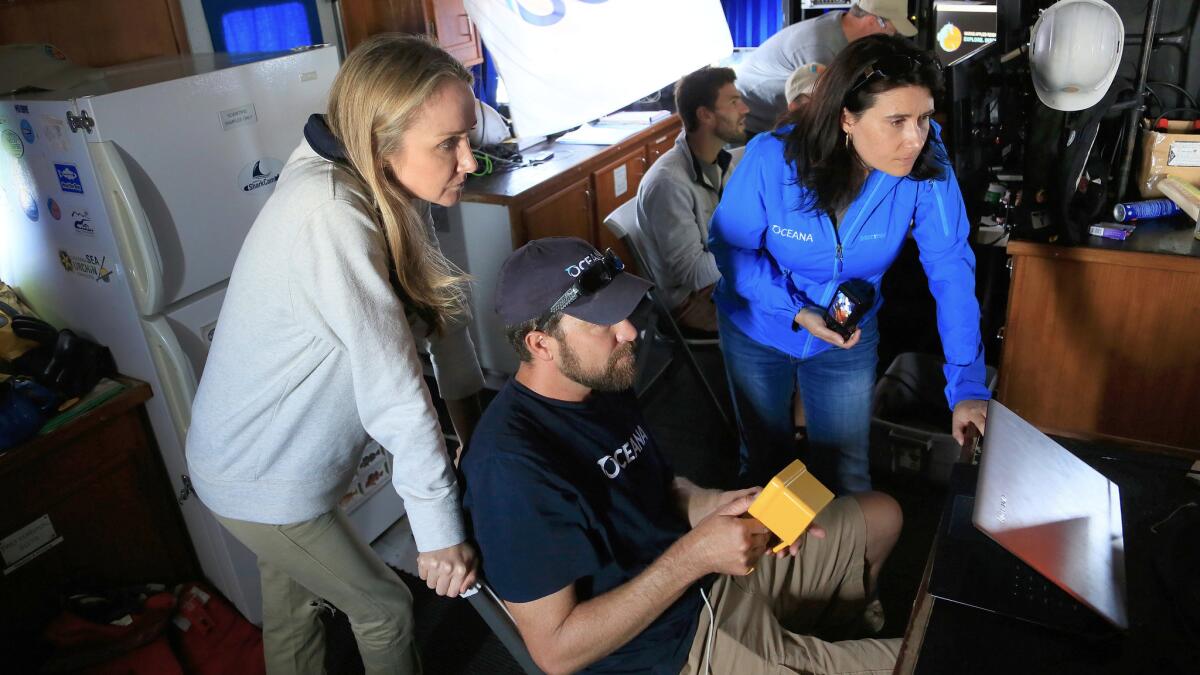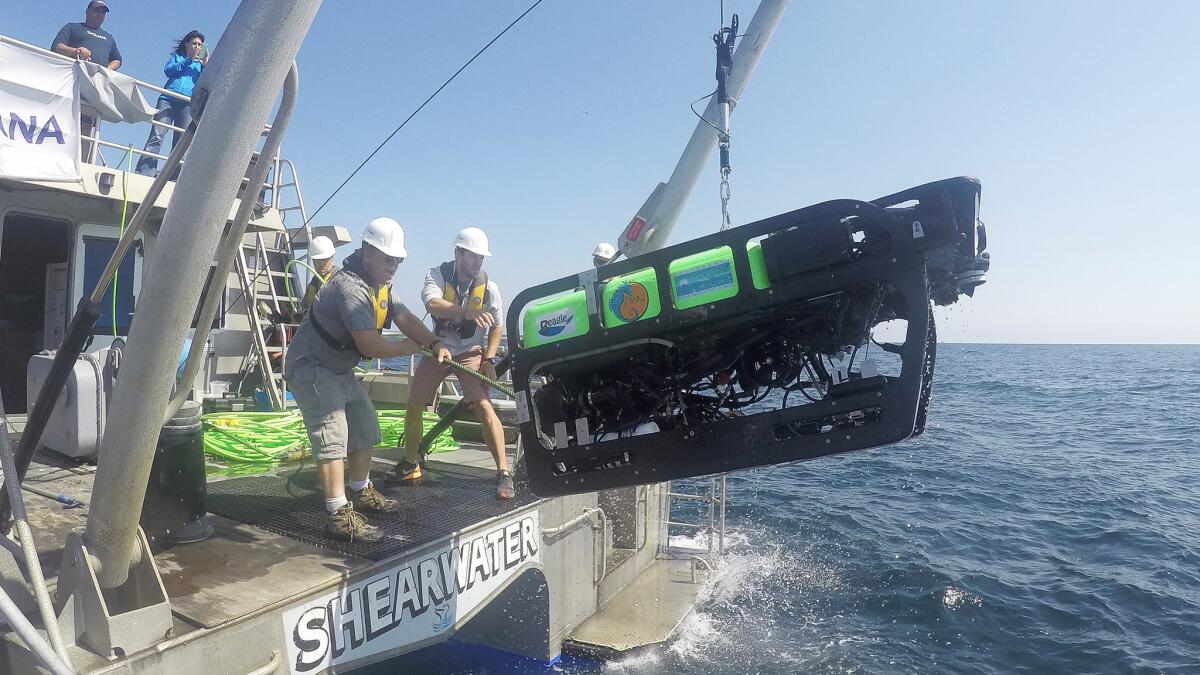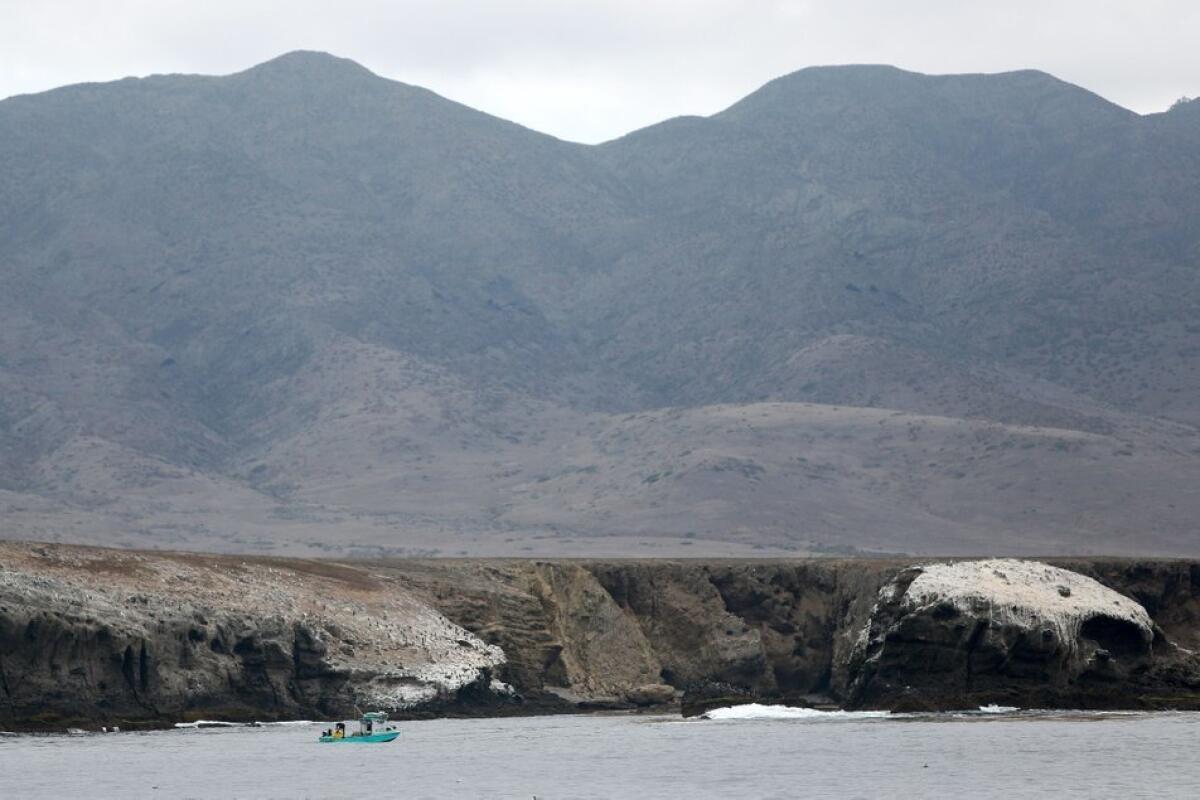Expedition documents sea life, habitat around Channel Islands
- Share via
Beneath the waves, flame-colored rockfish slipped past coral fans, brittle stars lay in wait for prey, and anemones swayed with the current.
It’s a scene often featured in photo spreads of tropical atolls and islets, but these coral gardens are in the chilly waters off California’s Channel Islands, hundreds of feet below the surface. Until recently, no one had seen them.
Earlier this month, the marine nonprofit Oceana launched a five-day expedition to document the undersea garden, using a remotely operated vehicle to film habitat too deep for divers to reach. It’s part of the group’s effort to secure new protection for a large swath of West Coast waters. And it’s a step into the unknown in our own backyard.
“We’re going to be astronauts today,” said Geoff Shester, Oceana’s California program director, as the crew embarked for the Channel Islands on the NOAA research vessel, the R/V Shearwater. “We’re going to be pioneers of a place that has 10 million people living around it, but nobody knows anything about.”
Only a small fraction of the sea floor is mapped, and scientists have just begun to take stock of its deep-water habitat, and the delicate sponges, corals, rockfish and eels that live there. Efforts to understand it have shown far more life on the sea bottom than scientists expected.
“Although fishermen had been picking up deep sea corals in their nets, and early scientists had collected these, there really wasn’t an appreciation for the rich habitat they create,” said Thomas Hourigan, chief scientist for the National Oceanic and Atmospheric Administration’s deep sea coral research and technology program. “And like shallow water coral, these deep sea corals are hot spots of biodiversity, providing habitat for invertebrate and fish species.”
On the final day of the expedition last week, the Oceana crew headed for a spot between Santa Cruz and Santa Rosa islands. They were joined by Alexandra Cousteau, granddaughter of the renowned ocean explorer, and by Austin Stowell, an actor in the Dolphin Tale films, who signed on to help Oceana. As crew members they shared duties ranging from operating equipment to tidying the galley. Cousteau, a senior advisor to Oceana, said she feels an urgent need to safeguard the ocean.
“The oceans are very different today than they were in my grandfather’s day,” she said. “They are so overfished, we’ve got climate change and ocean acidification, and oil and gas [drilling]. We’ve got to protect what we have…This is our life support system.”

As the ship powered out to the islands, scores of marine animals appeared; flocks of seabirds hovered over a ball of baitfish, and common dolphins raced in the ship’s wake.
Near Santa Cruz Island, the Shearwater made a stop at Painted Cave, one of the world’s largest sea caves. A quarter-mile deep and big enough for a ship to sail through, its 160-foot entrance revealed rock arches encrusted with red and green lichen.
The geologic marvel above the water hinted at features below it. Although much of the sea floor around the Earth is bare, sandy bottom, the sea floor off Southern California is pleated with rocky folds and ridges that harbor unique sea life.
“Already we’ve found amazing, bizarre phenomena,” Shester said.
On the ROV monitor, an olive yellowtail swam by, and a slew of ling cod, along with a hot pink rosy rockfish, and vermillion rockfish. There are over 100 species of rockfish, many of which congregate on the ocean bottom.
“They’re the dominant fish species in this ecosystem on the sea floor,” Shester said. “This is their grocery store. This is their home.”
Rockfish are prized for their sweet, mild flavor, and are a popular catch in Southern California. They’re among the longest-living fishes; one species may live 200 years, according to the Monterey Bay Aquarium.
Their longevity, low birth rates and late reproductive age leaves them vulnerable to overfishing. So researchers are eager to identify the nursery areas needed to replenish the fishery. They think these sea bottoms, with their rocky crevices and complex coral gardens, provide the cover the young fish need.
Throughout the week, the expedition documented Christmas tree corals, their dark branches covered in living ornaments of crabs, sea stars, barnacles and shark egg cases. Gold corals shone pale yellow under the ROV headlights. Researchers found red and purple sea fans and bright pink bubblegum coral.
Some are among the oldest organisms on the planet; single coral colonies have been dated at over 4,000 years old. Unlike their tropical counterparts, these grow slowly in cold depths below the reach of sunlight.
“So if these deep water corals are damaged, they can take decades, or hundreds of years to recover, if they recover at all,” Hourigan said.

That’s what Oceana hopes to head off with its proposal to the Pacific Fishery Management Council. In November the council, which manages U.S. fisheries from the edge of state waters to 200 nautical miles offshore, is updating its essential fish habitat for West Coast groundfish, including rockfish and other species.
Oceana is asking the council to place a swath of ocean from Northern California to the Mexican border off limits to bottom trawling, a fishing method that involves dragging a large net along the sea floor to catch target fish. In the process, however, it can also pull up corals and other organisms.
Most of the area that Oceana proposes to shut isn’t trawled, but the organization is calling for precautionary closures while researchers investigate it. Once they explore it, they say, scientists can sort out the most abundant areas from those without key habitat.

David Crabbe, a member of the fishery council and a commercial squid fisherman, said commercial fishermen would be more comfortable with the plan if there’s a specific mechanism to free up areas for fishing in the future.
“If they have a plan to reopen trawl grounds, that would give fishermen confidence that if impacts are shown to be minimal, that there’s a pathway to reopen it,” he said.
Shester said Oceana is OK with future fishing in less sensitive areas, but he argued that preserving biological hotspots supports both conservation and fisheries.
“If we can protect this habitat, that will protect the ocean, but also feed the world,” he said.
[email protected] Twitter @deborahsbrennan
ALSO
From Vietnam to Los Angeles: Photographer who captured iconic image on one road sees end of another
Firefighters slow Chimney fire’s path to Hearst Castle
Half dozen wildfires rage up and down California, destroying hundreds of homes
More to Read
Sign up for Essential California
The most important California stories and recommendations in your inbox every morning.
You may occasionally receive promotional content from the Los Angeles Times.









